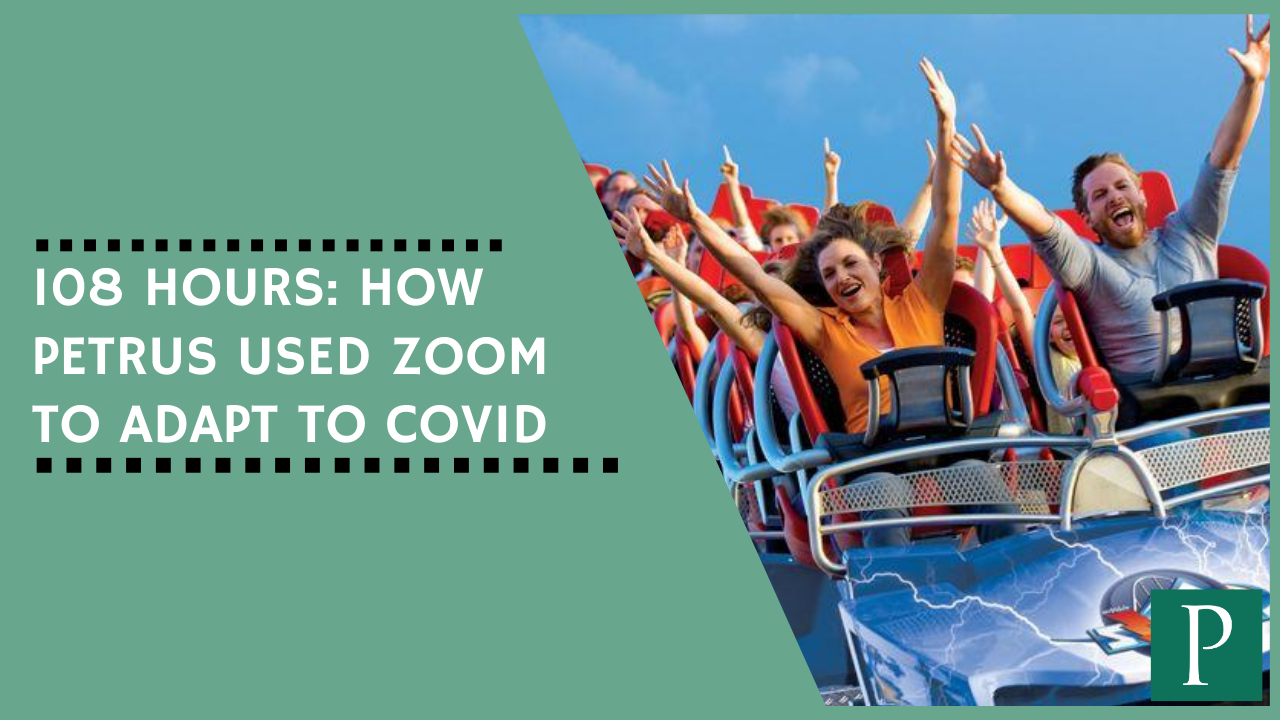108 Hours: How Petrus Used Zoom to Adapt to COVID

108 Hours...
No, this isn’t an intro to how I got stuck hiking in a Utah canyon, rather, it’s about Petrus that went from 12 hours of digital content to 108 hours’ worth of Zoom calls in 3.5 months because of a worldwide pandemic!
So what else could you do in 108 hours??
- Drive coast to coast 2.4 times
- Play 31 rounds of golf
- Watch 72 Disney movies
- Ride 3,465 roller coasters...
When I say we did 108 hours of Zoom calls, that’s what we pulled off. Now, I love roller coasters, and I have two girls and a little boy who I watch my fair share of Disney movies with; but 108 hours is a lot of time. How did we pull it off? Why does it even matter? And weirdly what does it even mean?
Lesson 1: Don’t be afraid to put yourself out there and attempt new ideas.
The first sign that things were going to be different came on March 11, 2020, when the Archdiocese of Seattle suspended all public Masses to prevent the spread of coronavirus. Many of the ministries Petrus works with depend on Sunday offertory and donations to sustain their annual budget. People were worried, even scared, and it was at this moment we realized we needed to bring people together. So, we launched the Virtual Summit March 17th.
After 14 straight weekdays of webinars in our Summit, we kept the conversation going with Virtual Lunch and Learns three days a week. As the date approached for our annual Petrus Conference, we had to make the decision to go virtual; but the question at the back of our minds was: “how will this be different from our daily webinars?” The solution was clear; a 55 hour nonstop live-streamed conference. 44 speakers, 61 sessions, 200 attendees from six countries and 2,000 messages bookmarked an amazing conference covering every Catholic fundraising topic you could imagine.
At the end of the day, each endeavor had its challenges and obstacles but ended up bearing so much fruit. We certainly put faith in God to sustain us, and He came through in so many incredible ways.
Lesson 2: Make a good plan...and prepare to pivot
On March 18, Darin Paine gave a great presentation about how to “Red Team” your development plans. This strategy requires one to spend time before the plan is executed by looking for and identifying all the ways that it could go wrong. The intent is to anticipate the issues ahead of time and build contingencies into the plan.
When we shifted from an in-person conference to a virtual conference, we spent hours in calls discussing the issues and problems that could arise. We knew we would need a strong web app, a plan, backup plans and our team under one roof when we launched our Virtual Conference. Through many meetings and brainstorming sessions, we were able to construct a solid plan to pull this off. It’s like Mike Tyson says, “Everyone has a plan, until they get punched in the face.” Winners expect those punches, adjust, and come up swinging.
Lesson 3: Virtual doesn’t have to be a plan killer
While switching to a virtual conference was not ideal (and was an incredibly disappointing decision to make at the time), there were countless positive outcomes as a result of the transition. It really is tough to be disappointed looking back. The number of conference attendees was nearly triple what it was the year before when we gathered in-person in Oklahoma City. An amazing outcome was that the Diocese of Marquette had four seminarians, multiple parish priests and even some campaign committee volunteers attend. We also had university presidents and two archbishops participate.
From the perspective of speaker recruitment, we only had one person decline to present at the Virtual Conference, and that response was due to a health condition. Going virtual allows presenters who would otherwise be unavailable to participate to be active and lend their expertise and experience to the attendees in some way. Looking forward to future conferences, workshops or training sessions, I will be more inclined to invite a speaker to virtually present at a training if being there in person is not possible. Before COVID-19, I had a healthy aversion to this, but my mindset has sufficiently shifted.
Lastly, I strongly encourage you to record the content and make it available to attendees afterward. We ran our virtual conference for 55 straight hours. I knew that nobody was intending to (or literally able to) watch everything live. Having all of the content recorded and available after the conference meant that attendees could step away and take a break or deal with other issues, knowing they could watch any missed sessions. It also meant that attendees could select sessions that would be impactful for others on their team, schedule time together, and watch and discuss as a group.
Lesson 4: Technical issues will come up
Even though we spent hours scrupulously planning, preparing and impeding technical problems, they still happened. Fortunately, we had a member of the team dedicated to providing tech support. In most cases, this meant walking admin, users and attendees through how to utilize the virtual tools. In a few cases, our tech support ended up on the phone with another company’s tech support line to determine what the problem was and how to troubleshoot it. The point is that it was important to have someone dedicated to helping with technical support. From the perspective of those on the team dealing with content and presentations, it was an immense relief to know someone was standing by to offer tech support.
For our Virtual Conference, we utilized the Whova app for conference organization and Zoom for the videoconferencing. Whova gave attendees a mobile and web app to communicate with us and other attendees. It also allowed them to post questions, interact directly with speakers, share resources, schedule virtual meetups, and follow along with the agenda. Implementing Whova was another decision that proved to be vitally important. I was extremely pleased with both tools and would use them again. We did realize some limitations of Whova once we got started and had to make some mid-conference pivots. We did not abandon the plan or tools, but had to adjust how we used them.
Once the conference was complete, we moved all our recorded content to the Petrus website for easy viewing. We transitioned to Kajabi as our website platform a few months ago in anticipation of offering more online content, so we were already set up for this.
If you are going to host videos and content on your website, I encourage you to look for a site platform that allows you to do that easily. Dropbox links and YouTube will work if you only have a few videos, but will limit you in some ways if your library continues to grow.
Lesson 5: Have fun
Throughout all of our Virtual Summit calls, Lunch & Learns, and the 55-hour Virtual Conference, we always made it a point to enjoy the journey by having as much fun as possible. Staring at screens constantly can be draining on your eyes and exhausting for your mind. We spent a lot of time planning the “fun parts” of our Virtual Conference. The sessions were comprehensive, yet we knew that having options for bonding and kicking back was just as important. Happy Hour, Fundraiser’s Feud, Pictionary...none of these were integral to the teaching part of the Virtual Conference, but they allowed attendees looking for that experience and the opportunity to engage. From a planning perspective, it gave the team breaks to look forward to as well.
All in all, the past 3.5 months has been a whirlwind of planning, acting, evaluating, reacting and celebrating. It took a lot of team effort, but it was just as important for the attendees to be sincere participants to make it all a success. There were so many lessons learned. I believe our team has grown and adapted to a new way of doing business quicker than if we had passively left it to others to lead the way.
I hope that our experience can offer you some insights, ideas and inspiration to make your own shifts and pivots. As a speaker on our Virtual Summit said back in March, “Even when the church doors are closed, the Church is always open.” Maybe opening your doors doesn’t include 108 hours of Zoom calls, but maybe it does. More than likely, it means looking at your ministry through a new perspective and coming up with solutions unique to your audience and your ministry. Whatever it is, I hope that our lessons learned can help move your ministry forward in some way.
There’s a great quote from the movie Lone Survivor, “anything worth doing is worth overdoing.”
108 hours is a lot but when the pandemic hit we, as a company, were at a cross roads. Everyone we knew and every client we had was scared, worried and reeling from something they’ve never dealt with before. We could not sit back. We could not stand on the sidelines. We had to do something.
And that’s what we did! 108 hours worth!
I would love to hear from you about how you overcame challenges and moved forward in your ways. Feel free to call, text or email me...or better yet, let’s Zoom!
Andrew
979.229.3183
READY TO BECOME A BETTER FUNDRAISER?
Sign up below to receive tools, ideas, and inspiration to take your development efforts to the next level.
We hate SPAM. We will never sell your information, for any reason.


